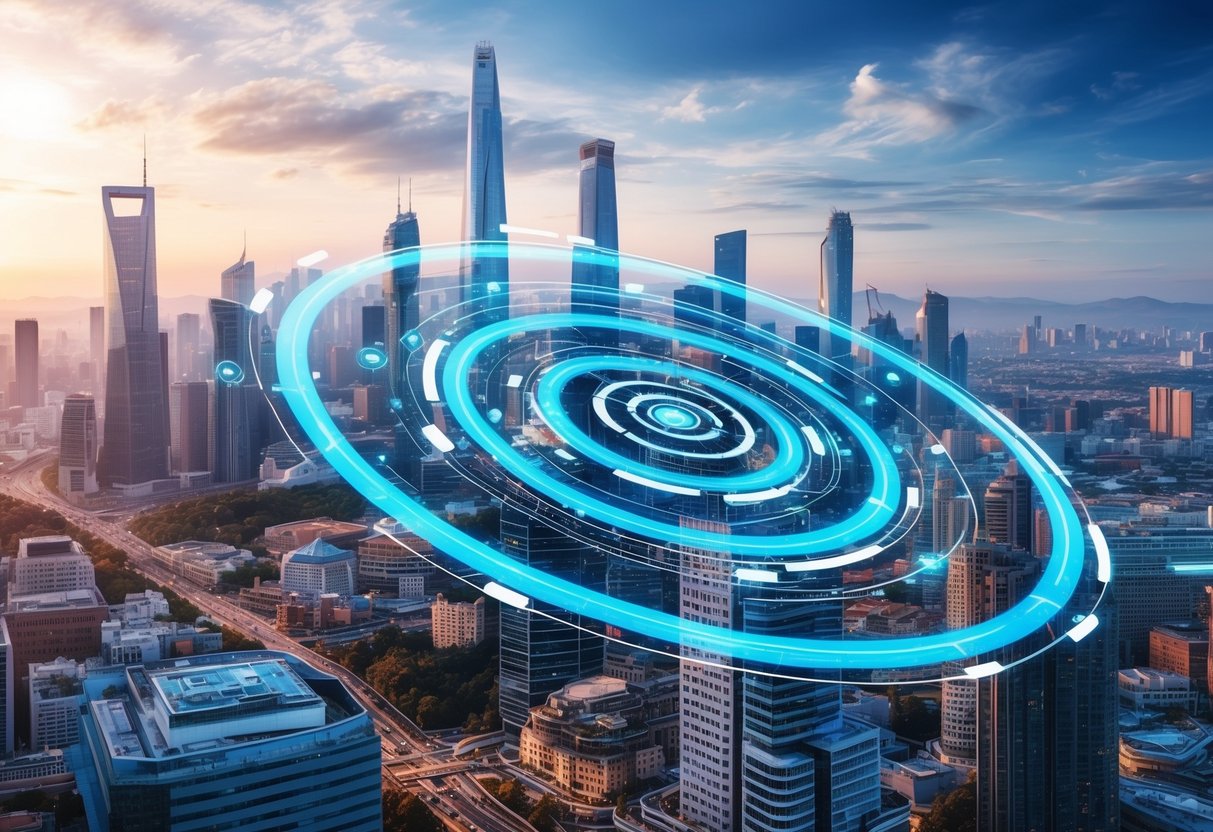New Information Technology Trends Taking Businesses By Storm In 2025: Innovations Reshaping Industries
The digital landscape is evolving, and businesses are scrambling to keep up with the latest technological advancements. As we approach 2025, several key trends are revolutionizing IT departments and reshaping how organizations operate. From artificial intelligence to green tech, these emerging technologies are set to transform industries and create new opportunities for innovation and growth.
You’ll find that staying ahead of the curve is crucial in this rapidly changing environment. The top strategic technology trends for 2025 represent powerful new tools to overcome productivity, security, and innovation challenges. By embracing these technologies, you can position your business for success in an increasingly digital world.
Key Takeaways
- Quantum computing and AI advancements will revolutionize data processing and decision-making capabilities.
- 5G technology and edge computing will enable faster, more efficient connectivity and real-time data analysis.
- Sustainable IT practices and green technologies will become essential for environmentally conscious businesses.
The Rise of Quantum Computing
Quantum computing is revolutionizing information processing and reshaping technological landscapes. This emerging field promises to solve complex problems at unprecedented speeds, transforming industries and opening new frontiers in scientific research.
Impact on Cryptography
Quantum computers pose significant challenges to current encryption methods. They have the potential to break widely used cryptographic algorithms, jeopardizing data security across sectors. As a result, quantum-resistant cryptography is becoming a critical focus for cybersecurity experts.
You’ll need to update your security protocols to prepare for this shift. Consider implementing post-quantum cryptography solutions to safeguard your sensitive data. Quantum key distribution offers a promising avenue for secure communication in the quantum era.
Businesses and governments are investing heavily in developing quantum-safe encryption methods. Stay informed about these advancements to protect your digital assets effectively.
Speed Advancements in Data Processing
Quantum computing’s processing power far exceeds that of classical computers for certain tasks. You can expect dramatic improvements in data analysis, optimization, and complex simulations across various industries.
Quantum algorithms could revolutionize portfolio optimization and risk assessment in finance. In healthcare, drug discovery processes may be significantly accelerated.
Your business can benefit from quantum-inspired algorithms even before fully-fledged quantum computers become widely available. These algorithms apply quantum principles to classical systems, offering performance boosts in logistics and supply chain management.
Keep an eye on quantum cloud services. They allow you to experiment with quantum computing without significant infrastructure investments.
Advancements in Artificial Intelligence
Artificial intelligence is rapidly evolving, transforming businesses across industries. Key developments in natural language processing, business analytics, and ethical AI governance reshape how companies operate and make decisions.
Natural Language Processing Breakthroughs
Natural language processing (NLP) made significant strides in 2025. You can now interact with AI systems using conversational interfaces that understand context and nuance. These systems can generate human-like text, translate languages in real time, and summarize complex documents with remarkable accuracy.
In many customer service scenarios, AI-powered chatbots and virtual assistants have become indistinguishable from human agents. They can handle complex queries, provide personalized recommendations, and detect and respond to emotional cues.
NLP advancements have also revolutionized content creation. You can now use AI tools to draft articles, create marketing copy, and write code with minimal human input.
AI in Business Analytics
AI has transformed business analytics, enabling you to make data-driven decisions in real-time. Predictive analytics models can now accurately forecast market trends, customer behavior, and potential risks.
Machine learning algorithms can process vast amounts of structured and unstructured data, uncovering insights that were previously impossible to detect. This has led to more efficient supply chain management, targeted marketing campaigns, and optimized pricing strategies.
AI-powered dashboards provide dynamic visualizations and actionable insights, allowing for quick and informed decision-making across all levels of your organization.
Ethical AI and Governance
As AI becomes more prevalent, ethical considerations and governance have taken center stage. AI governance platforms are now essential for ensuring responsible AI development and deployment in your organization.
These platforms help you monitor AI systems for bias, ensure transparency in decision-making processes, and maintain compliance with evolving AI regulations. You can now implement safeguards to protect user privacy and prevent the misuse of sensitive data.
Ethical AI frameworks have been developed to guide the creation of AI systems that align with human values and societal norms. This includes considerations for fairness, accountability, and the potential societal impact of AI technologies.

Blockchain Beyond Cryptocurrency
Blockchain technology expands beyond its cryptocurrency roots, revolutionizing industries and transforming business processes. Its applications in supply chain management and decentralized finance are noteworthy, offering enhanced transparency, efficiency, and security.
Supply Chain Transformation
Blockchain is reshaping supply chain management, providing unprecedented traceability and transparency. You can now track products from origin to consumer with immutable records.
This technology enables real-time monitoring of goods, reducing delays and fraud. Smart contracts automate processes, streamlining operations and cutting costs.
For food and pharmaceutical industries, blockchain verifies product origins and ensures authenticity. You can easily trace contaminated items, facilitating quicker recalls and enhancing consumer safety.
Blockchain also improves inventory management. You’ll have accurate, real-time data on stock levels, reducing overstock and stockouts.
Decentralized Finance Innovations
Decentralized finance (DeFi) is disrupting traditional financial systems. With DeFi, financial services can be accessed without intermediaries, reducing costs and increasing accessibility.
Smart contracts automate lending, borrowing, and trading processes, eliminating the need for traditional banks in many transactions.
DeFi platforms offer higher yields on investments compared to traditional savings accounts. You can earn interest on cryptocurrency holdings through yield farming and liquidity provision.
Blockchain-based identity verification simplifies KYC processes. This makes opening accounts and accessing financial services faster and more secure.
Cross-border transactions become near-instantaneous and low-cost. You can send money globally without exorbitant fees or long processing times.
5G Technology and Edge Computing
5G and edge computing are revolutionizing how businesses operate and deliver services. These technologies enable faster data processing, reduced latency, and enhanced application connectivity.
Enhancing the Internet of Things (IoT)
5G networks and edge computing are transforming IoT capabilities. You can now connect more devices and sensors to gather real-time data with unprecedented speed and reliability. This allows for smarter and more efficient operations across various industries.
In manufacturing, you can implement predictive maintenance systems that detect equipment issues before they cause downtime. Smart cities benefit from improved traffic management and energy distribution. Healthcare providers can utilize remote patient monitoring with instant data transmission.
The 5G and edge computing combination supports processing massive amounts of IoT data locally. This reduces bandwidth requirements and improves response times for critical applications.
Transforming Mobile Workforce
5G and edge computing are reshaping how mobile workforces operate. You can now access high-bandwidth applications and services virtually anywhere, enhancing productivity and collaboration.
Remote workers benefit from near-instantaneous access to cloud resources and augmented reality applications. Field technicians can leverage real-time data and AI-powered diagnostics to solve complex issues on-site.
Mobile video conferencing and virtual collaboration tools perform seamlessly, eliminating lag and disruptions. This enables more effective remote teamwork and client interactions.
Edge computing brings powerful processing capabilities closer to mobile devices. You can run resource-intensive applications locally, reducing reliance on centralized data centers and improving performance.
Augmented Reality and Virtual Reality
AR and VR technologies are revolutionizing how businesses operate and engage with customers. These immersive technologies offer new ways to showcase products, train employees, and create interactive experiences.
AR in Retail and Marketing
AR is transforming the retail landscape by allowing customers to visualize products in real-world settings. You can now try on virtual clothing or see how furniture fits in your home before making a purchase. This technology enhances the shopping experience and reduces return rates.
Major retailers are integrating AR into their mobile apps and websites. Virtual fitting rooms and product visualization tools are becoming commonplace. AR also enables interactive advertising campaigns, where you can scan posters or packaging to access additional content or promotions.
Businesses are using AR to create engaging in-store experiences. For example, you might encounter AR-powered displays that provide product information or virtual store guides to help you navigate large retail spaces.
VR for Training and Simulations
VR is revolutionizing employee training across industries. You can now participate in realistic simulations without real-world risks or costs. This technology is particularly valuable in high-risk professions like healthcare, manufacturing, and aviation.
Companies are using VR to create immersive onboarding experiences. You can explore virtual office spaces and meet colleagues before your first day. VR training modules allow you to practice complex procedures or customer interactions in a safe environment.
The technology is also being used for soft skills development. You can practice public speaking, conflict resolution, and leadership skills in virtual scenarios. VR’s ability to simulate various environments makes it an invaluable tool for preparing employees for diverse workplace situations.
Cybersecurity in a Hyperconnected World
As digital ecosystems expand, robust cybersecurity measures become crucial for protecting interconnected networks and sensitive data. Advanced threat detection and IoT device security are key focus areas for organizations in 2025.
Emerging Threats and Defense Mechanisms
AI-powered attacks are becoming more sophisticated, requiring equally advanced countermeasures. To stay ahead of these evolving threats, you’ll need to invest in AI-driven defense systems. Machine learning algorithms can analyze patterns and detect anomalies faster than traditional methods.
Quantum computing poses new risks to encryption. To prepare, you should start transitioning to quantum-safe encryption methods. This proactive approach will safeguard your data against future quantum attacks.
Zero Trust architectures are gaining traction. You’ll need to implement continuous authentication and least-privilege access controls. This approach assumes no user or device is trustworthy by default, enhancing your overall security posture.
Security in IoT Devices
The proliferation of IoT devices introduces new vulnerabilities to your network. You must prioritize securing these endpoints to prevent them from becoming entry points for attackers.
Implement robust authentication protocols for all IoT devices. Use unique, complex passwords and enable two-factor authentication where possible. Regular firmware updates are essential to patch known vulnerabilities.
Consider network segmentation to isolate IoT devices from critical systems. This strategy limits the potential damage if a device is compromised. Employ intrusion detection systems specifically designed for IoT networks to identify suspicious activities promptly.
Educate your team on IoT security best practices. Encourage them to disable unnecessary features and regularly audit connected devices. By fostering a security-conscious culture, you’ll strengthen your organization’s defense against IoT-related threats.
Automation and Robotics
Automation and robotics are revolutionizing industries in 2025. As these technologies become more sophisticated and widespread, you’ll see dramatic changes in manufacturing processes and healthcare delivery.
Industry 4.0 and Smart Manufacturing
Smart manufacturing is transforming production lines. AI-powered robots are working alongside human employees, increasing efficiency and precision. These collaborative robots, or cobots, can handle repetitive tasks while you focus on more complex operations.
Advanced sensors and Internet of Things (IoT) devices now monitor every aspect of the production process. This real-time data allows you to optimize workflows and predict maintenance needs before breakdowns occur.
3D printing has become integral to manufacturing. You can now produce custom parts on demand, reducing inventory costs and accelerating product development cycles.
Service Robots in Healthcare
Service robots are making a significant impact in healthcare settings. Robotic assistants help with patient care and logistics in hospitals.
Surgical robots have improved precision in complex procedures. As a result, minimally invasive surgeries with faster recovery times are now possible.
In elder care, companion robots provide social interaction and monitor health metrics. These devices can alert you or medical staff to potential health issues before they become serious.
Robotic exoskeletons are helping patients with mobility issues. These wearable devices can help you regain independence and improve your quality of life.
Sustainable IT and Green Technologies
As we approach 2025, sustainable IT and green technologies are becoming increasingly crucial for businesses. These innovations are not only environmentally friendly but also cost-effective in the long run.
Cloud sustainability is emerging as a key trend. It involves optimizing cloud services to reduce energy consumption and carbon emissions. This approach allows you to scale your IT infrastructure more efficiently while minimizing environmental impact.
Green data centers are another area of focus. These facilities use renewable energy sources and advanced cooling systems to reduce their carbon footprint. You can significantly lower your company’s indirect emissions by choosing providers with green data centers.
Digital enablement technologies are also gaining traction. These include:
- Smart building systems
- Energy management software
- Virtual collaboration tools
These solutions help you reduce physical resource consumption and travel-related emissions.
Climate tech is becoming increasingly important in the business world. You’ll find new technologies designed to monitor, reduce, and mitigate environmental impacts across various industries.
E-waste management is another critical aspect of sustainable IT. Implementing proper recycling and disposal protocols for electronic devices helps minimize environmental harm and can even recover valuable materials.
Adopting these sustainable IT practices and green technologies positions your business for long-term success while contributing to global environmental goals.
The Future of Remote Work
Remote work continues to evolve rapidly, transforming businesses. Advanced technologies are reshaping collaboration and productivity for distributed teams.
Cloud Systems and Collaboration Platforms
Cloud-based infrastructure is becoming essential for seamless remote work. More companies are adopting cloud systems to enable secure access to data and applications from anywhere.
Virtual collaboration tools are advancing to create more immersive remote experiences. Improvements in video conferencing, virtual whiteboards, and project management platforms are expected.
AI assistants are enhancing remote work efficiency. These tools will help you automate routine tasks, schedule meetings, and provide real-time language translation for global teams.
Hybrid work models are becoming the norm. Flexible arrangements allow employees to split time between home and office as needed.
Cybersecurity measures are adapting to protect remote workers. VPNs, multi-factor authentication, and endpoint security solutions will be used more frequently.
Digital Twins in Industry and Urban Planning
In 2025, digital twins will revolutionize industries and urban planning. These virtual replicas of physical assets or systems provide real-time insights and optimization opportunities.
In manufacturing, digital twins enable predictive maintenance and process optimization. They allow you to monitor equipment performance, identify potential issues before they occur, and streamline production lines.
Urban planners are leveraging digital twins to create smarter, more sustainable cities. Tallinn’s digital twin integrates real-time data from utilities, infrastructure, and the environment. This allows you to make quicker, more informed decisions about urban development.
Key benefits of digital twins in urban planning include:
- Improved traffic management
- Optimized energy consumption
- Enhanced disaster preparedness
- Better waste management
In healthcare, digital twins of patients help you personalize treatments and predict outcomes. You can simulate various treatment scenarios before implementing them in real life.
The global digital twin market is projected to grow from $21.1 billion in 2024 to $119.8 billion by 2029. This rapid expansion is driven by advancements in IoT, AI, and cloud computing.
As you implement digital twins in your business or city planning efforts, you’ll gain valuable insights that drive efficiency, sustainability, and innovation.
Contents
- 1 New Information Technology Trends Taking Businesses By Storm In 2025: Innovations Reshaping Industries
- 2 The Rise of Quantum Computing
- 3 Advancements in Artificial Intelligence
- 4 Blockchain Beyond Cryptocurrency
- 5 5G Technology and Edge Computing
- 6 Augmented Reality and Virtual Reality
- 7 Cybersecurity in a Hyperconnected World
- 8 Automation and Robotics
- 9 Sustainable IT and Green Technologies
- 10 The Future of Remote Work
- 11 Digital Twins in Industry and Urban Planning

 55 Park Road,
55 Park Road, 




